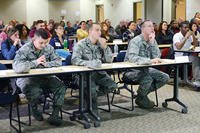Question #1:
With so many Diploma Mills around, how can I judge the quality of an online education program?
Answer:
You can't judge an online school by their campus. Many nationally accredited colleges and universities offer only distance learning and online programs. This means they don't need a fancy college campus to deliver a quality education.
Here a couple of quick ways to judge an online school and avoid Diploma Mills:
Is the school accredited by either a Regional or National accreditation association? These associations include:
- ACICS - Accrediting Council for Independent Colleges and Schools
- DETC - Distance Education and Training Council
- MSA - Middle States Association
- NEASC - New England Association of Schools and Colleges
- NCA - North Central Association of Colleges and Schools
- NWCCU - Northwest Commission on College and Universities
- SACS - Southern Association of Colleges and Schools
- WASC - Western Association of Schools and Colleges
See our page "Why You Should Care About Accreditation for more details.
Question #2:
How does a school determine how many credits to give me for my military experience and training?
Answer:
College credit for military experience is determined by the American Council on Education (ACE). ACE evaluates hundreds of military courses, schools, AFSCs, MOSs and ratings each year. Each ACE evaluation includes a curriculum description, course length, dates and recommended credits listed for both upper (bachelor's) and lower (associate) levels.
Note: Not all schools grant ACE recommended credit for military experience, so it is vital that you shop around for the school that works best for you. Learn more about getting college credit for your military experience.
Question(s) #3:
What the heck is the difference between semester hours and quarter hours? Does a two-year degree actually take two years? What is a master's degree? What is financial aid?
Answer(s):
Many new students have questions about the academic terms and language of college education. The following is a list of terms, definitions and examples to help remove the language barrier. We like to call it College 101:
|
Associate Degrees: |
Associate Degree | This degree can take an average of two years, however it can be completed more quickly. |
| Associate of Arts (A.A.) | Usually 60 (SH) units (L.L.), which usually requires a foreign Language. An Associate of Arts degree takes two years on average, however it can be completed more quickly. | |
| Associate of Science (A.S.) | Usually 60 (SH) units (L.L.), which generally requires less Arts and more Sciences, and has no foreign Language requirement. | |
| Associate in Applied Science (A.A.S.) |
Usually 60 (SH) units (L.L.), which are mostly professional in nature, like Electronics Technician, Machinery Technician, etc. | |
|
Bachelor's Degrees: |
Bachelor of Arts (B.A.) | Usually 120 (SH) units (L.L. and U.L.), predominately Arts and Sciences with a foreign language requirement, such as degrees in Mathematics, Literature, Theology, etc. |
| Bachelor of Science (B.S.) | Usually 120 (SH) units (L.L. and U.L.) Less Arts and Sciences with no foreign language requirement, such as degrees in Business, Aeronautics, Communications, etc. | |
| Master's Degrees: | Master of Arts (M.A.) | Graduate Level Studies in Arts and Sciences such as History, Biology, Mathematics, etc. Thesis Project required in most cases. |
| Master of Science (M.S.) | Graduate Level Studies in professional areas such as Accounting, Marketing, etc. Thesis required in most cases. | |
| Master of Business Administration (MBA) | Graduate Level studies in Business related areas such as Human Resource Management, Organization Development, E-Commerce, etc. | |
| Lower Level | Associate Level Courses | Courses that range from basic to intermediate level, such as English 101, Introductory Algebra 1a, etc. |
| Upper Level (U.L.) | Bachelor's Level Courses | Courses that range from intermediate to advanced levels, such as Abnormal Psychology 401, Calculus, Organization Behavior. |
| Credit Hours | Semester Hours (SH) | Most schools run under the Semester System. This is how the school grants credit for course completion. A normal course is usually worth three credit hours. |
| Quarter Hours (QH) | Some schools run under the Quarter System. This has no effect on the quality of the courses, or the cost. It is simply a different means of measuring credits. To figure your credits if you plan to transfer from a Quarter system to a Semester system school, you generally divide your Quarter credits by 1.5. | |
| Fees | Tuition and Lab | The cost associated directly with the course being taken. |
| Administrative, Transcript, Evaluation, Etc. | These Fees are general to college enrollment. They are not usually covered by Military Tuition Assistance Programs. | |
| Evaluation | When you begin the enrollment process, most schools will conduct an evaluation of your existing college credits to determine how many of your courses or Military experience credits will transfer to your new school. | |
| Financial Aid | Financial Aid is any form of grant or loan that is paid directly to the college. This includes Stafford Loans, Perkins Loans, Pell Grants, and Military Tuition Assistance. However, MGIB is not considered Financial Aid (because it is paid to you not the school). | |
| Registrar's Office | The College Administration office that normally handles your VA GI Bill (MGIB) paperwork. | |
| Distance Learning | Distance Learning is any form of education that does not require classroom attendance including Online, Video Tapes, Correspondence, Etc. | |
| Degree Program | The list of courses or modules that are required to earn a specific degree. | |
| Residency requirement | The number of credits a student must earn directly from the school (not by transfer), to earn a degree from that school. Example: Northern Eel River Community College may require you to take a minimum of 30 credits from them to earn a diploma. |
.





